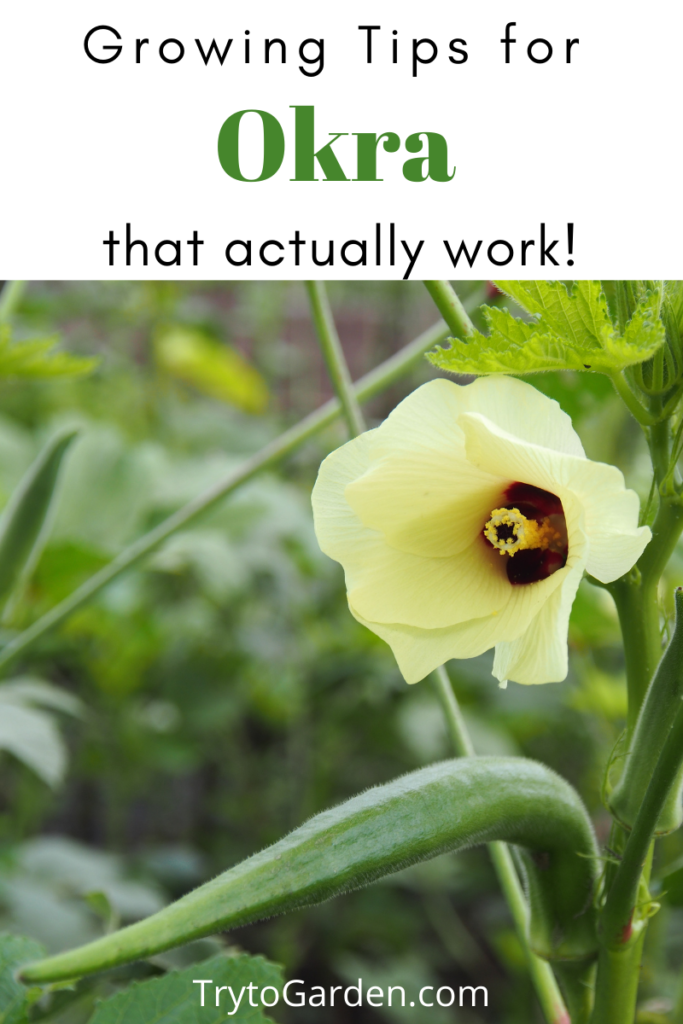This post contains affiliate links, which means I will make a commission at no extra cost to you should you click through and make a purchase. As an Amazon Associate I earn from qualifying purchases.
Okra's slimy, gummy qualities make it unfavorable to many cooks except for those who specialize in southern dishes such as gumbo and, of course, the appetizer fried okra.

Growing okra in an organic vegetable garden can produce a far better yield of this plant than a non-organic garden. Supplying the right amount of organic compost in well-drained soil will help okra thrive and have a fresher taste.
Gardening Tips for Okra That Actually Work!
While it looks like a ridged pepper, it belongs to the same family as hibiscus and cotton, and likely came to the U.S. from Africa more than three centuries ago.
A tropical plant originating in Ethiopia, okra made its way to the Nile and the Middle East sometime during the 13th century. It made its first appearance in the southern states of North America in the early 1700s, being brought over by the black slave trade.
Early American Indians used okra as a thickening agent for stews made of vegetables and seafood or, as we know it today, "gumbo." In England, a stew similar to our gumbo might be called Lady's Fingers, and in the Caribbean, Kallaloo, all of which contain okra.
Benefits of Okra
According to Healthline:
Okra is a nutritious food with many health benefits. It's rich in magnesium, folate, fiber, antioxidants, and vitamin C, K1, and A. Okra may benefit pregnant women, heart health, and blood sugar control. It may even have anti-cancer properties.
The benefits of consuming this gem range from fighting cancer to aiding in breastfeeding, lowering your sugar for diabetes, and even helping with your bone health if you are fighting osteoporosis.
Although mainly used fresh, it can be dried, ground into a powder, and then the powder used as a thickening agent in soups and stews, sort of like corn starch.
Ranging in size from about two-inch to eight inches, the okra pods are finger-like in shape. They are slightly curved and come to a point on one end. Okra usually has a green color ranging in shades from light to dark, but there are a few varieties that have a reddish color to them. Some varieties might have slight fuzz on them and/or ridges It kind of reminds me of milkweed pods with ridges.
The seeds generally germinate in two to 12 days. Okra will grow in many soil types, so mulch and fertilize as needed.
Plant it in the spring or early summer once the threat of frost has passed. To prevent the seeds from rotting, the soil should have warmed to at least 65 degrees. Gardeners in cool regions may want to start their seeds indoors in peat pots four to six weeks before the area's final frost date.
This grows best at temperatures between 75 and 90 °F. When planting okra, gardeners want to ensure that the soil temperature is warm enough so that seeds germinate and begin to grow, as cool soils can lead to slow growth and seedling diseases.
If your plants have ideal conditions, they can produce 20 – 30+ pods per plant. They suggest you plant 6 okra plants per person enjoying the harvest.
It is pretty incredible. The leaves, flowers, and seeds are also edible. Young okra greens can be cooked like spinach or beet greens (or eaten raw) and the seeds can even be ground and used as a coffee substitute. It has a sweet, grassy flavor and the pods can be eaten raw or cooked but cooked usually wins out.
Because larger-sized okra tends to be woody when cooking with okra, choose the smaller tenderer pods.
Planting Okra
Okra seeds should be planted in the organic vegetable garden after all danger of frost has passed, in well-drained soil, rich with organic compost.
Sow seeds one inch deep, four to six inches apart, in rows, spaced one and one-half to two feet apart.
It does well in dry weather but may need to be watered in dry periods extend past a week. Also, keep weeds down in your organic vegetable garden by pulling them, spreading straw, or organic mulch.
This is a prolific plant, so often check for pods during the summer growing months.
Harvest the pods when they are between two and four inches. Use a sharp knife to remove the pods from the plant, and be careful when handling the pods as they bruise easily.
This gem is great canned, frozen, or pickled. I use it in home-made soups, gumbos, and stews and then freeze them. I also freeze washed and cut okra to add to my soups and stews in the wintertime.
Easy Recipe
While it is a popular staple in Creole cooking, itokra shows up in stir-fry, and I would have to say fried okra tops the list. We have rounded up a great recipe for you to make the last - it's a great crowd pleaser/appetizer.
